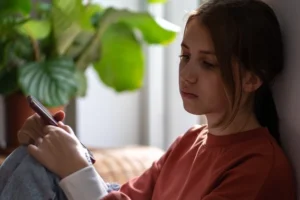In Beth’s family, ten-year-old Charlie is the most enthusiastic user of technology. He enjoys playing video games on his Xbox, and also uses his parents’ iPad and old phones to watch YouTube videos, play online games and make TikTok videos.
Experiences of seeing inappropriate content
Earlier this year, Charlie was playing on YouTube when he managed to access some inappropriate content. “Charlie was watching kids’ videos and started clicking on the recommended video links that come up at the end,” explains Beth. “He ended up watching some videos of teen YouTubers who were playing pranks, but also using some really strong, provocative language.”
It’s not the first time Charlie has experienced the downside of online content. When he was younger, he managed to rack up hundreds of pounds on his grandparents’ phone bill by spending money on an online football game.
“We’ve definitely learned the importance of using PIN numbers to protect devices, but mostly it’s been about talking to Charlie,” explains Beth. “He’s been told he can only subscribe to purely gaming channels that we know are suitable. I’ve also watched those channels myself, so I know it’s suitable for his age group.”
With regards to making online purchases without permission, Charlie was asked to write an apology letter to his grandfather. “After the initial panic, we all calmed down and explained how the games worked, and that it was real money that was being spent,” Beth adds.
Balancing safety concerns and giving children the freedom to explore
For parents, allowing children more freedom online can be worrying. Beth says she would have appreciated more controls within the games and videos themselves, so children simply cannot access overly adult or commercial content. “I also think schools could do more to explain the dangers. We’re given a leaflet at the start of term, but more practical first-hand experience would work better than pages of text,” says Beth. “It needs to be aimed at the children themselves, so they gain an understanding.”
View on Age Verification law
Beth is supportive of the idea of legislation of Internet platforms, but she worries how effective the proposed age verification legislation will be. “For instance, most social networks require children to be 13 to sign up, but I know that half of Charlie’s class have Instagram and Facebook pages at the age of 9 or 10. More definitely needs to be done to protect kids, especially on YouTube, where anyone can upload content that looks innocuous but can turn sinister in seconds,” she says.
Using a variety of tools to keep children safe
Over the past few months, Beth and her husband have made a few changes at home. This has included adding fingerprint recognition to all devices that are associated with credit cards and using setting to ensure this is always required to make a purchase.
Charlie is now using the YouTube Kids app, which isn’t perfect but does reassure Beth that Charlie is less likely to stumble across inappropriate content. “I think with Charlie being my eldest it’s been a minefield, but I feel a lot more in control and aware of what can happen for my younger children,” she says.
Parents share concerns on inappropriate content
What did surprise Claire about her experience was how common it was among other parents. “Once I mentioned it, so many friends and family had similar stories,” says Beth. “One friend’s three-year-old had been watching a Peppa Pig episode when Peppa turned into a demon and started attacking the other characters. She was incredibly distraught.”





